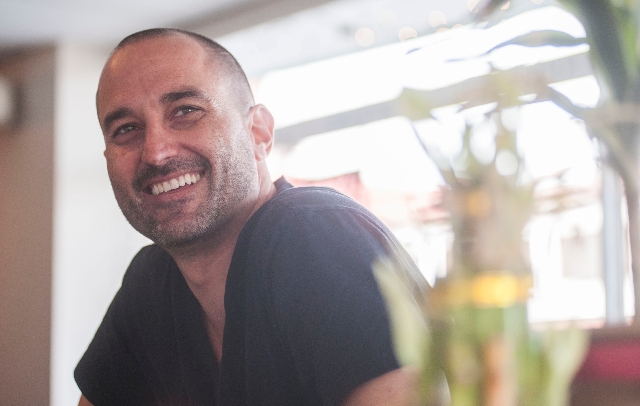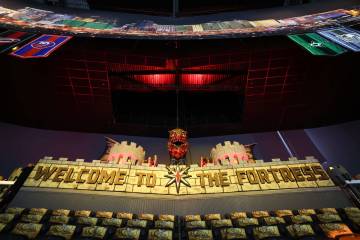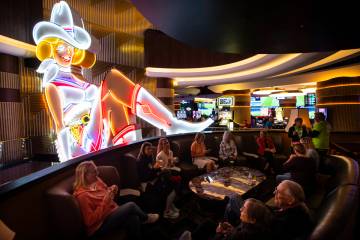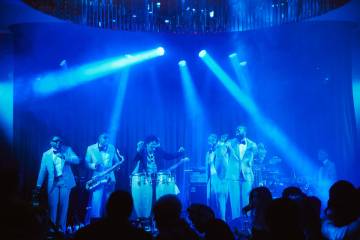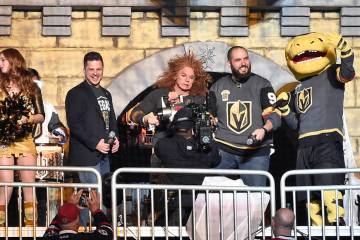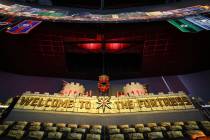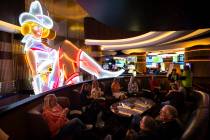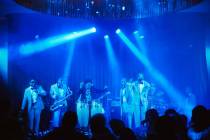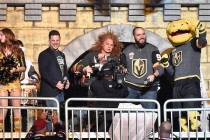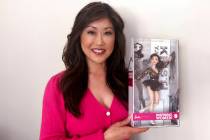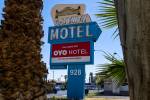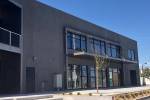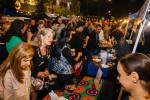First Friday manager revels in art’s energy, creativity
On 29 days each month, Joey Vanas is a popular guy in downtown Las Vegas.
Before he even arrives for a conversation at The Beat, a coffeehouse at Sixth and Fremont streets, a customer overhears that Vanas will be stopping by.
“Joey’s coming?” she asks, offering that she’ll stop by later in hopes of catching him. Then, after Vanas does arrive, and twice within the span of just an hour, friends who notice him stop by to say hello.
On 29 days a month, Joey Vanas is a popular guy in downtown Las Vegas. And on the 30th day?
You could make a good case that, on that day, Vanas is the most important guy in downtown Las Vegas.
That’s because Vanas is managing partner of First Friday Las Vegas LLC, the organization that in October 2011 took over the ownership of First Friday from homegrown nonprofit Whirlygig Inc. That means he oversees the art walk/street festival/general happening that each month draws thousands of locals and tourists to downtown Las Vegas’ Arts District.
When Vanas became involved with First Friday, “I think we started with 30 to 35 (vendors), and we have well over 100 now,” Vanas says. “We started with one stage and we’re going to four stages now. One bar, and we’ve got four of those now. It was one block, now it’s five real-kind-of blocks. So it’s definitely grown in size and scale.”
Vanas concedes that putting together a First Friday every 30 days is a challenge. But, in retrospect, Vanas has been accidentally training for this gig his entire career.
Vanas was born in Naples, Fla., and spent much of his career in business and marketing. He first moved to Las Vegas in 2004 — and spent about four years here — when the Miami-based investment group he worked for moved its operations here.
Before that, while attending the University of California, Los Angeles, Vanas occasionally would visit Las Vegas for fun. When the bars closed in Los Angeles, “we’d get the great idea that we’d hop in the car and drive four hours to Las Vegas,” he says.
He wasn’t impressed. Vanas considered himself more of a beach bum/surfer/snowboarding kind of guy, and being “in a flat desert that has alcohol and casinos and clubs and everything else just didn’t seem like a place that made a lot of sense for me,” he says.
“Also, I felt like this whole city was a giant facade, and if you ever put your hand through the wall a little too far you’d fall through the wall and on the other side the Joker would be there and grab your wallet and kick you out on the other side,” he says, laughing. “And that was Vegas to me.”
Vanas left town in 2008, spent about a year-and-a-half doing marketing work elsewhere, and returned to Las Vegas, “looking for something that mattered, something meaningful.”
Vanas joined a friend in launching a line of yoga clothing. Along the way, he became friends with Tony Hsieh, head of Zappos, the Southern Nevada-based online retailer. When Hsieh learned that the operators of First Friday were putting it on hiatus and that First Friday might even end, he called Vanas.
“Tony just said, ‘Well, we can’t let it go away,’ ” Vanas recalls. “He brought it to me and said, ‘First Friday. What’s your take on this?’ I said, ‘Well, I have a lot of takes on it.’ ”
Vanas considered First Friday important for changing people’s notion not just of downtown Las Vegas but of Las Vegas in general. He, himself, was proof of that, noting that, after attending his first First Friday in 2006, “I was blown away. It completely changed my perception of Las Vegas.”
Vanas told Hsieh that whoever took over responsibility for First Friday would inherit some challenges. The event had been going for eight years at that time, and there had been a lot of ups and downs, Vanas says, as there had been “a lot of infighting.”
First Friday also was “losing a large sum of money,” Vanas says, and merely breaking even would be “a best-case scenario, and it could take a year, it could take more.”
Vanas sent Hsieh his thorough analysis — “There were three or four bullets there,” Vanas says, laughing — and “he responded almost immediately, like 10 seconds later: Are you in or are you out?’ ”
“Oh, man,” Vanas says, smiling. “It was one of those times in my life where it was just, like, ‘I don’t know. I have no idea.’ ”
Vanas lost sleep over the decision for a few weeks. As he mulled it over, he visited the Burning Man, the outdoor festival held each year in Northern Nevada, where he felt an “incredible energy” and “creativity like I had never felt before. It was amazing.”
And it hit him: Art, Vanas says, is “human beings communicating over something in a nonverbal way, coming together and creating something together and sharing an experience around it and an appreciation of it.”
“That’s pretty powerful stuff,” Vanas says. “I ran back in, found my phone, found a signal and wrote back: ‘Hell yeah, man. Let’s do it.’ ”
Still, First Friday’s evolution has left some in the arts community wondering exactly what — Street festival? Art walk? — it is.
When he attended his first First Friday in 2006, “what I found was definitely focused around art, but it was really more of an outdoor gathering,” Vanas says.
First Friday defies an exact explanation and description, he notes.
“We do have a lot of artists there and, at its core, that is what it is intended to be and we want to keep it that way,” Vanas says. “We always want to make this a place where artists can show their work.”
Then, Vanas continues, “you’re going to get into the question of what is art and what isn’t art. Should we classify it as all visual? Do performing arts fit into that category? I think it does.”
Jerry Schefcik, director of the Donna Beam Fine Art Gallery at the University of Nevada, Las Vegas, has been attending First Friday since Day One. From his perspective, it has changed over the years, evolving from art walk, where patrons would walk from gallery to gallery and, perhaps, purchase a piece or two, to more of an “artists’ festival.”
“In talking to artists and gallerists, I think there is the feeling it has become less about the art and more about the festivity of the evening,” Schefcik says.
Initially, gallery owners had hoped the event would attract potential buyers to downtown.
“The sense I got was (that) wasn’t happening the way they hoped First Friday would be,” Schefcik says. “I have students that go to First Friday, and what they have voiced is it’s not so much about the art, it’s seeing and being seen.”
Yet, First Friday also attracts to the Arts District thousands of people who might otherwise not stop by.
“It’s not a black-and-white issue,” Schefcik says. “I don’t know there’s another event in Las Vegas that draws Las Vegans like this one does.”
(Schefcik notes, too, that downtown gallery owners have created their own event, Preview Thursday, when galleries are open and a more serious art crowd is catered to.)
While First Friday still is not making money, or even supporting itself, it is “going in the right direction,” Vanas says. The bulk of its funding still comes from the event’s partners — Vanas says they’re currently putting in about $20,000 a month to make First Friday happen — and Hsieh “does a lot of the heavy lifting on the financial side of it, fortunately.”
Challenges aside, Vanas loves the creative energy each First Friday generates. He recalls last month’s event, when he joined a group of festival producers from across the country watching a performance by Nevada Ballet Theatre while, nearby, a Burning Man-type praying mantis spewed fire.
Vanas says one of his guests voiced, excitedly and in colorful language, the notion that such a juxtaposition could occur only in Las Vegas.
And, Vanas says, smiling, “he was kind of right.”
Contact reporter John Przybys at jprzybys@reviewjournal.com or 702-383-0280.
FIRST FRIDAY
May’s edition of the downtown event, which runs from 5 to 11 p.m. Friday, will feature the merging of science and art.
The Arts District, centered around Casino Center Boulevard and Colorado Avenue, will include more than 75 artists, 15 live bands and DJs on four stages, and other entertainment.
Among this month’s attractions:
■ Airborne Raptors Unlimited will offer guests up-close views of Nevada’s wildlife at the welcome tent at the First Friday entrance, near Charleston and Casino Center boulevards.
■ At The Hub, on Casino Center Boulevard near Colorado Avenue, guests can enjoy interactive activities and learn about the science of flight from Monarch Sky, which will have a real helicopter on hand.
■ Also at The Hub, at 6:30 and 8:30 p.m., Social Paintbrush will offer free art lessons. Meanwhile, The Art of Law will offer free seminars about basic legal issues, inside their tent at Casino Center Boulevard and California Street.
■ From 5 to 9 p.m., KidZone, off Casino Center Boulevard and California Street, will feature art lessons for kids by animators from The Chuck Jones Experience, while the Las Vegas Science & Technology Festival will offer planetarium activities, plant painting and lessons in animal tracking. Also featured will be ’70s-inspired art projects by Boys & Girls Clubs, a petting zoo from Roos N More, pet adoptions by The Animal Foundation and a performance by the Banana Slug String Band at 8:30 p.m.
Refreshments will be provided by food trucks on Third Street between Colorado and Imperial avenues.
Free parking, as well as paid $5 parking, will be available, and shuttle bus service will run from 4:30 to 11:30 p.m.
Fremont Route shuttle stops are at El Cortez (pickup and dropoff on Sixth Street, across from the El Cortez valet entrance); Golden Nugget, at the lobby doors just south of Rush Tower; and the Arts District Hub at Colorado Avenue and Main Street.
The Clark County Government Center shuttle route has stops at the Government Center and the Arts District Hub at Colorado Avenue and Main Street.
Additional free parking will be available at the City Hall garage at Stewart Avenue and Las Vegas Boulevard (then walk to the Fremont shuttle stops).
For handicap transportation, call 736-6491
For more information and a complete schedule of events, visit the First Friday website (firstfridaylasvegas.com) .



